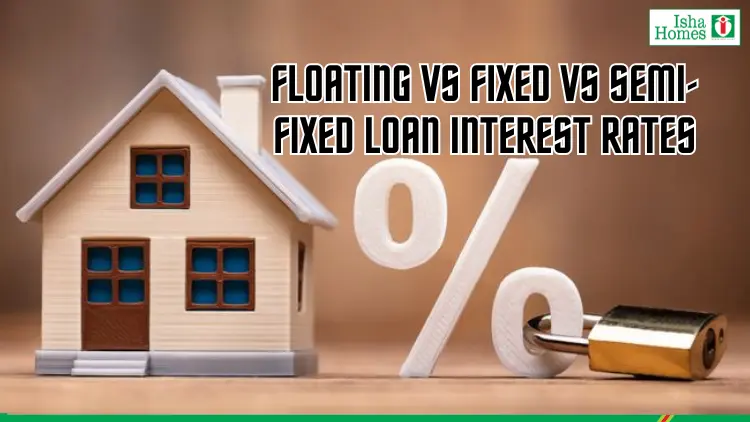Taking a loan is one of the biggest and most crucial decisions in life. Besides availing a loan from the bank, the red tape associated with it, and the repayment, it is significant that one should know how the interest rate is calculated. There are three such types of interest-rate loans, floating loans, fixed loans, and semi-fixed loans. We have compiled everything you need to know about floating, fixed, and semi-fixed loans. This article aims to discuss the differences between the three types of interest-rate loans so readers can decide which is best.
Understanding Various Interest-Rate
The interest rate has a huge effect on the loan repayment amount. You must understand the types of interest rates before taking out a loan. Floating, fixed, and semi-fixed loans offer various interest rates. As the name suggests, floating interest rates have fluctuating interest rates. They may change according to the market’s fluctuations. It has a risk of increased interest rates. Fixed interest rates come with a fixed rate throughout the loan term. It is suitable for the long term and protects you from an unstable market. In the case of semi-fixed loans, the rate would start as fixed and may change into a floating rate if need be. Follow along to learn each of them in detail.
Fixed Interest Rate
Fixed-interest rate loans are loans with an unchanged interest rate throughout the loan duration. Most borrowers prefer fixed-interest loans since they can easily predict the interest rate throughout the duration. Moreover, it offers them peace of mind. In other words, it translates to predictable monthly payments (EMI).
For example, imagine you are taking a loan amount of Rs. 10 lakhs to buy a car with an interest rate of 10%, and the EMI payment is Rs. 23,000. This will allow you to easily pre-plan your expenses to avoid unexpected increases in the interest rate.
Benefits of fixed interest rate loans
The benefits of fixed interest rates are that they are predictable and make it easy to manage expenses. It safeguards you from hikes in interest rates. The decision can be taken after analyzing the market condition and the interest rate in the environment.
Drawbacks of fixed interest rate loans
Fixed rates often come with slightly higher interest rates compared to floating loans. You may have to pay penalties in case you repay the loan in advance. Most importantly, in case the price drops in the future, you will still have to pay the previously fixed amount.
Types of Fixed Interest Loans
Auto Loans
An auto loan typically features a fixed interest rate, necessitating borrowers to make consistent monthly payments over a predetermined duration. When individuals apply for an auto loan, they must offer the vehicle they intend to purchase as collateral. Additionally, both the borrower and the lender establish a repayment plan, which might involve an initial down payment and regular installments covering both the principal amount and interest.
For example, if a borrower in India acquires a car loan of ₹15,00,000 at a 10% interest rate payable in a span of two years, the borrower will pay back the loan according to the given loan period, i.e., two years. Along with monthly installments of ₹68,750, the borrower would have to repay the loan’s principal amount within the loan’s term. If the borrower makes a ₹4,00,000 down payment on the loan amount, the EMIs that will be for the entire period of the loan will be ₹56,250.
Mortgage
A mortgage is a kind of low variable-cost loan acquired by a buyer to purchase his/her property or real estate. Lenders, in a mortgage contract, give out cash advances in return for installments for a certain period. The borrower obtains the loan, uses it to buy a home, and then provides the property as collateral for the loan until the entire loan is paid up. Take a fixed rate mortgage, where the most common type is a 30-year mortgage, and the payments are spread evenly over the period of 30 years (a weekly or bi-annually fixed percent of the loan amount). Period Payments are payments to be made towards loan principal and interest.
Floating Interest Rate loans
Both fixed and floating loans have their advantages and disadvantages too, which are distinct with the prevailing interest rates. Depending on a variety of factors, including the period of the loan and the trend of interest rates, the borrower may go in for either fixed or variable rates. For example, in the case of home loans, the borrower has the option of choosing the interest rate. They may go for a fixed home loan, one in which the interest does not change, a variable home loan that varies with the market rate, or a hybrid option between fixed and variable rates. This variety empowers borrowers to select a loan structure that aligns with their financial goals and risk tolerance.
Floating loans can have an initial interest rate lower than fixed-rate loans. Even at low interest rates, people are attracted by its flexibility. Originally, the cheaper rate could result in a lower monthly payment for borrowers, which might be a cost-saving solution for the short term.
Floating loans have the advantage of being customizable to a business’s changing needs, but the unpredictability of interest rates adds to the level of uncertainty that borrowers face. Should interest rates fluctuate on the market, the monthly payments will do so as well. This may lead to higher payments if rates rise and lower payments if they go down. This innate uncertainty is what makes particular loans more difficult to predict than they would be for traditional fixed-rate ones, whereby borrowers would know exactly the amount they should pay every month.
Semi-fixed Interest Rate Loans
A proper blend of both semi-fixed interest loans and hybrid loans is known by the other name, i.e., a half-fixed interest rate loan. These loans provide borrowers with a combination of staticity and flexibility, so at first, they are fixed-cap evidence for some time, and then after this, they will be on a floating interest rate system. A combination of these two tactics has the borrowers enjoy the characteristics of fixed rates initially but also offers them an opportunity to gain from the downside of floating rates when the time comes.
Compared to that, say you are on a semi-fixed home loan for 30 years. The loan may commence with a fixed rate for the first 5 years, which may enable borrowers to plan and have regular and predictable payments within the first period. The fixed term, which will most likely be the first period of the loan, will be the initial fixed rate, and the interest rate can then adjust periodically as market conditions change.
The major benefit of semi-fixed loans is that they help save the borrowers an extra amount while the interest rates keep going up. The temporary duration of the period initially favors borrowers because they are insured from fluctuations in the market interest rate. Thus, when the fixed rate period is over, loan recipients risk the costs or benefits of the new floating rates, depending on the conditions of the market.
That is to say that semi-fixed interest rate loans bring settlement stability to borrowers through a regular settlement of payments on the repayment of their loans. The combination model is meant to satisfy those who want, on the one hand, certainty high enough and, on the other hand, flexibility to take care of their financial obligations.
Key Points to Consider While Taking a Loan
- Evaluate the existing and predicted interest rates to decipher whether fixed-rate, floating-rate, or semi-fixed-rate loan components would be more fitting. Weigh in factors like economic matters and financial advisers’ forecasts.
- Determine the strength of your finances in terms of your ability to accommodate different repayment schemes. Fixed loans are quite convenient as they offer stability, making them suitable for those who desire predictability. However, floating-rate loans come with flexibility, but they also carry the risk of increased payments during the loan period.
- Figure out the length of the loan term and think about whether it matches the goals you’ve set for yourself financially. Short-term loans may offer benefits for borrowers who desire to avoid additional interest costs, while long-term loans provide favorable monthly loan payments yet come with higher interest over time.
- Take stock of your personal risk appetite and the degree of uncertainty you are ready to assume. Fixed-rate loans are more certain to pay, but they will cost you more at the beginning, and floating-rate loans can be a cheaper option if you’re ready to face the risk of an increase in payments.
- Besides your plans, it is also important to think of things like expected changes in income and lifestyle and how they can affect your capacity to regularly pay your loan obligations. Opt for a loan that allows adjustments to your income and expenditure patterns so that it keeps up with changes.
- Give a review of the conditions of all types of loans, including the penalties for prepayment service and other limitations, to ensure everything is done according to your wishes and needs.
That’s a wrap!
Choosing the most suitable type of loan can be successful only after you have taken different factors into account. Either a fixed-rate, floating-rate, or semi-fixed loan mortgage is an option for borrowers, and they should check whether they can afford it or not, tolerate the risks, and what their goals after such a long period are. A loan with a fixed rate is an appropriate option for people who prefer to have a stable and uniform pattern of payments, whereas floating-rate loans are attractive for people who prefer to have flexibility but take the risk of payment fluctuations. Semi-variable rate loans provide a middle ground between the former two, with their fixed rate constancy at the start and floating rate potential prospects over some time. As for types of loans, the interest rate, the loan terms, and the loan requirements should be taken into consideration, implying that an informed choice matters. The process of comparing the three types of loans can be confusing, If you feel so, do not hesitate to reach out to professionals to get it sorted. It is highly suggested that you seek professional help to arrive at a better decision.



